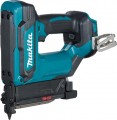Min. pin thickness
The smallest diameter of the attachment pin (see Attachment Type) that the stapler can handle.
The tool cannot effectively capture a workpiece that is too thin, and, accordingly, effective clogging is out of the question. However this limitation can be so small that it can be neglected — in particular, because such thin pins for general use are simply not produced. Therefore, the minimum pin diameter is indicated relatively rarely, and mainly in cases where it exceeds 0.5 mm.
Min. pin length
The shortest length of the attachment pin (see Attachment Type) that the stapler can handle.
Parts of small length are clogged relatively easily and do not require much effort, however, fasteners that are too short simply will not be captured by the tool and will “shoot” as expected. Therefore, modern staplers often have a limitation not only on the maximum, but also on the minimum length of the pin. This option is especially relevant if you plan to work with small details.
Battery platform
The name of the battery platform supported by the device. A single battery platform is used to combine various power tools of the same brand (screwdriver, grinder, circular saw, etc.) into one line. Devices on the same platform use interchangeable batteries and chargers. Thanks to this, for example, there is no need to select a battery for each individual model of a power tool, because one purchased as a spare battery can be used in various power tools, depending on the situation or as needed. Batteries of the same platform basically differ from each other except perhaps in capacity.
Battery voltage
The operating voltage of the battery installed in the tool of the corresponding type (see above).
The higher the power of the stapler, the higher the voltage may be required (but not necessarily required) to power it efficiently. In other words, a high battery voltage is usually indicative of advanced performance, while a low battery voltage is not always a sign of an entry-level tool. From a practical point of view, this parameter may be useful only for some specific tasks — for example, searching for an external charger for a battery or buying a spare battery. In addition, this parameter must be taken into account when comparing different batteries in terms of capacity (for more details, see "Battery Capacity") .
Modern staplers most often use 12 V and
18 V batteries.
Compatible batteries
Battery models compatible with the tool.
When choosing a tool, this information is relevant mainly for models without a battery included. For tools that come with batteries, the battery model is more of a reference—it's mostly "for the future" if a spare or replacement battery is needed. However, this data can also be useful in the selection process — for example, to assess compatibility with an existing battery on the farm, or to find detailed data on compatible batteries and determine how they meet your requirements (in particular, there are formulas that allow you to determine the time of continuous operation from a specific battery; these formulas can be found in special sources).

